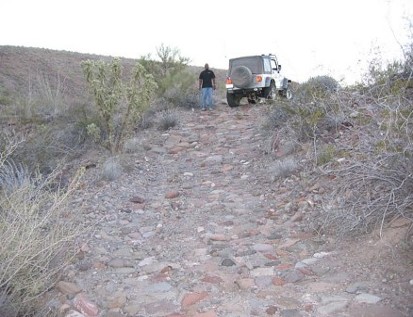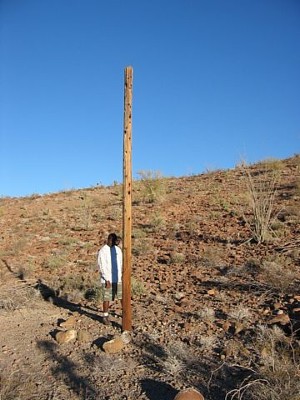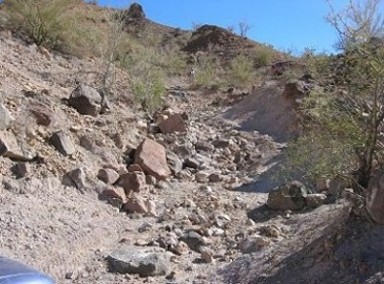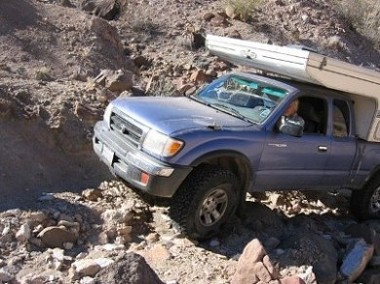| Pages:
1
2
3
4 |
Ken Cooke
Elite Nomad
     
Posts: 8969
Registered: 2-9-2004
Location: Riverside, CA
Member Is Offline
Mood: Pole Line Road postponed due to injury
|
|
"Doing The Pole Line Dance" by Neal Johns



|
|
|
wessongroup
Platinum Nomad
       
Posts: 21152
Registered: 8-9-2009
Location: Mission Viejo
Member Is Offline
Mood: Suicide Hot line ... please hold
|
|
Pretty cool Ken... thanks for the info...
|
|
|
David K
Honored Nomad
        
Posts: 65344
Registered: 8-30-2002
Location: San Diego County
Member Is Offline
Mood: Have Baja Fever
|
|
The cobblestone road was built by the U.S. in WWII

|
|
|
David K
Honored Nomad
        
Posts: 65344
Registered: 8-30-2002
Location: San Diego County
Member Is Offline
Mood: Have Baja Fever
|
|
Very few poles remain along the Pole Line Road!

|
|
|
David K
Honored Nomad
        
Posts: 65344
Registered: 8-30-2002
Location: San Diego County
Member Is Offline
Mood: Have Baja Fever
|
|
Serious off road type vehicles required... 'Basketball Hill' and other sections of the run are not on the cobblestone paved roadbed!

|
|
|
David K
Honored Nomad
        
Posts: 65344
Registered: 8-30-2002
Location: San Diego County
Member Is Offline
Mood: Have Baja Fever
|
|
Neal and Marian Johns (pictured below), Roy 'The squarecircle', and Ken Cooke are all Pole Line Road masters!

|
|
|
Skipjack Joe
Elite Nomad
     
Posts: 8088
Registered: 7-12-2004
Location: Bahia Asuncion
Member Is Offline
|
|
"Neal Johns is a retired Federal (missiles and rockets) Electronics Engineer whose has been fascinated with the desert for almost 60 years".
I'm confused. I thought Neal was an aridologist. 
|
|
|
David K
Honored Nomad
        
Posts: 65344
Registered: 8-30-2002
Location: San Diego County
Member Is Offline
Mood: Have Baja Fever
|
|
| Quote: | Originally posted by Skipjack Joe
"Neal Johns is a retired Federal (missiles and rockets) Electronics Engineer whose has been fascinated with the desert for almost 60 years".
I'm confused. I thought Neal was an aridologist.  |
Being fascinated with the desert IS what makes him an aridologist! 
|
|
|
bajaguy
Elite Nomad
     
Posts: 9247
Registered: 9-16-2003
Location: Carson City, NV/Ensenada - Baja Country Club
Member Is Offline
Mood: must be 5 O'clock somewhere in Baja
|
|
Historical reading
| Quote: | Originally posted by David K
The cobblestone road was built by the U.S. in WWII |
Anything in writing about the Pole Line Road and US involvement in Mexico during WWII..........
And why would they cobblestone a short section of the road????
|
|
|
David K
Honored Nomad
        
Posts: 65344
Registered: 8-30-2002
Location: San Diego County
Member Is Offline
Mood: Have Baja Fever
|
|
Neal read about the road in the Lower California Guidebook, and went to check it out... Ken and others followed. I have not (yet) been on it... Other
than the Lower California Guidebook, I don't know of any other published information... Something to research!
|
|
|
Ken Cooke
Elite Nomad
     
Posts: 8969
Registered: 2-9-2004
Location: Riverside, CA
Member Is Offline
Mood: Pole Line Road postponed due to injury
|
|
I have looked and researched, but have found nothing published on this route other than that of Gerhard and Gulick. Neal Johns showed me this route
once - in 2004.
Along the Pole Line Road

|
|
|
Neal Johns
Super Nomad
   
Posts: 1687
Registered: 10-31-2002
Location: Lytle Creek, CA
Member Is Offline
Mood: In love!
|
|
bajaguy,
They only "paved" a few hills.
My motto:
Never let a Dragon pass by without pulling its tail!
|
|
|
David K
Honored Nomad
        
Posts: 65344
Registered: 8-30-2002
Location: San Diego County
Member Is Offline
Mood: Have Baja Fever
|
|
Neal, I am a bit curious as to the route of the pole line on to San Felipe from the section you guys have driven on (between the summit and Arroyo
Grande/ La Ventana). Ensenada to the summit, as well (but that would seem obvious, except why didn't they just continue along the 'road' to Valle de
Trinidad and out through the San Matias Pass...?).
Why go over the summit and across such harsh and remote terrain instead of the more direct and shorter route???
|
|
|
TMW
Select Nomad
      
Posts: 10659
Registered: 9-1-2003
Location: Bakersfield, CA
Member Is Offline
|
|
| Quote: | Originally posted by bajaguy
And why would they cobblestone a short section of the road???? |
Probably to keep the rains from damaging them, at least in that area.
|
|
|
Ken Cooke
Elite Nomad
     
Posts: 8969
Registered: 2-9-2004
Location: Riverside, CA
Member Is Offline
Mood: Pole Line Road postponed due to injury
|
|
| Quote: | Originally posted by David K
Why go over the summit and across such harsh and remote terrain instead of the more direct and shorter route??? |
Personally, I believe the area over the Summit, up and over Basketball Hill, and across Arroyo Grande less likely erode when compared with the San
Matias Pass region.
|
|
|
TMW
Select Nomad
      
Posts: 10659
Registered: 9-1-2003
Location: Bakersfield, CA
Member Is Offline
|
|
The run up the San Matias wash is a lot easier that the summit. Soft sand instead of rocks.
|
|
|
David K
Honored Nomad
        
Posts: 65344
Registered: 8-30-2002
Location: San Diego County
Member Is Offline
Mood: Have Baja Fever
|
|
It would be really cool to find original records of the project... Can you imagine a time when U.S. troops were traveling around Baja to have an early
warning on a Japanese/ German sneak attack? The El Rosario mesa airstrip and San Felipe radar station (and telephone line to it) are just two
examples.
|
|
|
wessongroup
Platinum Nomad
       
Posts: 21152
Registered: 8-9-2009
Location: Mission Viejo
Member Is Offline
Mood: Suicide Hot line ... please hold
|
|
It is really something to think about... a different time for sure... hard to believe
Great thread...
|
|
|
David K
Honored Nomad
        
Posts: 65344
Registered: 8-30-2002
Location: San Diego County
Member Is Offline
Mood: Have Baja Fever
|
|
| Quote: | Originally posted by wessongroup
It is really something to think about... a different time for sure... hard to believe
Great thread... |
I am doing some research and I just read (and I recall from another time) that the U.S. troops could not be in uniform while in Mexico.
|
|
|
David K
Honored Nomad
        
Posts: 65344
Registered: 8-30-2002
Location: San Diego County
Member Is Offline
Mood: Have Baja Fever
|
|
The Internet is awesome...
Mexico and the Defense of California
American concern for the security of Mexico was intimately related to the extent and proximity of any threat to United States territory. After the
attack on Pearl Harbor, the security of Baja California became a matter of acute interest to the United States. Just as lend-lease was a manifestation
of American interest in the security of Mexico, so the measures taken by General DeWitt and General Card##as, singly and jointly for the defense of
the United States' southwest and Mexico's northwest were concrete expressions of Mexican cooperation in the defense of the United States.
There were three fields of activity in which the defense of California involved joint action with Mexico: first, the placing of aircraft detector
stations in Baja California; second, the building of airfields and highways there; and third, the formulation of joint plans by General DeWitt and
General Card##as.
The proposal to establish radar stations in Baja California grew out of a study made by the GHQ Air Force early in 1941, disclosing that vital areas
in the southwest, near the Mexican boundary, could not be adequately covered either by a ground observation system or by radar detectors in American
territory. "An enemy desiring to attack Southern California," a later Air Forces report stated, "may be expected to be aware of the limitations of our
Aircraft Warning Service, and will make his approach over or from Mexican territory. " 74 The Air Forces therefore recommended taking steps to obtain
Mexico's permission to establish at least two detector stations in Baja California. These views were brought to the attention of the War Plans
Division sometime in April. Without denying the merits of the proposal, the War Plans Division informed the Army Air Forces that the moment was not
propitious for discussing the subject with the Mexican staff representatives, then in Wash-
[356]
--------------------------------------------------------------------------------
ington. The Air Forces continued to agitate the matter during the next three months, only to receive the same reply: "The War Department considers it
inadvisable to submit to the Mexican representatives a request to station detachments of U.S. Army armed and uniformed forces in Mexican territory, as
it is convinced that the Mexican Government would reject such a request at this time." 75 In framing the War Plans Division reply, Colonel Ridgway,
then serving as one of the American staff representatives, noted, "there is no probability of securing Mexican consent . . . at least until an Axis
attack is delivered or imminent." 76
No action was taken until 3 December 1941, four days before the attack on Pearl Harbor, when the American staff representatives presented their
Mexican colleagues with a proposal for an immediate reconnaissance of Sonora and Baja California for the purpose of locating sites for radar stations.
Although it was agreed that the necessity of using the installations might never arise, the American representatives nevertheless proposed that the
preliminary steps be taken at once and that small mixed groups of United States officers and Mexicans, in civilian clothes, should survey the area
within two hundred miles of the border for access roads and radar sites.77 An appeal on 8 December brought a reply from President Avila Camacho the
same day giving full permission to make the reconnaissance and install the radar stations. To the original purpose the Air Staff had, however, added
that of investigating rumors of Japanese airfields and fuel caches. A separate party under Maj. A. P. Ebright conducted the Air Staff survey, entering
Mexico on 16 December. An attempt by the War Department to identify the Ebright mission with the radar station reconnaissance no doubt contributed to
the initial confusion and suspicion that attended it.78 Although no signs of enemy activity were uncovered, the Ebright party remained in Mexico until
the end of January to investigate suitable sites for landing fields, to report on the availability of water and other supplies along the route of
communications from the border south, and in general to add to the Army's store of information about the area.79 As the immediate post-Pearl Harbor
frenzy subsided and as the scope and positions of the Ebright mission became clarified,
[357]
--------------------------------------------------------------------------------
General DeWitt's Western Defense Command headquarters gave it firmer support against the continued skepticism at the headquarters of the Southern
California Sector.80 Meanwhile, other groups had crossed the border, and had tentatively chosen sites for radar detector stations at Punta
Salispuedes, 20 miles northwest of Ensenada; Punta San Jacinto, 125 miles south of Ensenada; and Punta Diggs on the northeast coast of the peninsula.
With all this activity going on, the issue that had threatened the negotiations over staging fields the previous summer-whether Mexico would permit
the entry and stationing of armed and uniformed American soldiers promised to become a hardy perennial. On the earlier occasion, it had been solved by
accepting the Mexican position, and when the proposal for the reconnaissance of Baja California was presented to the staff representatives on 3
December the wearing of civilian clothes by the soldiers making the survey was accepted by the American representatives as inescapable. The first
draft of the instructions for `the reconnaissance, drawn up on 9 December for the Chief of the Army Air Forces, stated, "United States personnel will
be limited to officers and they will wear civilian clothing," but at the suggestion of G-2, and with the concurrence of Colonel Ridgway, this
particular restriction was deleted.81 Because of the United States' belligerent status, it was no longer appropriate. General DeWitt was especially
insistent that no soldiers cross into Mexico unless in uniform and armed, but the point was not raised with Mexican representatives in Washington.
Consequently, the Ebright group was turned back at the border and not permitted to cross until the men changed into civilian clothing and left their
weapons behind. Sometimes, depending on the attitude of the local Mexican commanders, American parties were permitted to enter the country in uniform,
but never under arms, and not even the excellent personal relations that existed between General DeWitt and General Card##as could bring about a
definite acceptance of the American view. The War Department as well as the Department of State took the position that, unsatisfactory though it might
be to send American soldiers into Mexico in civilian clothes and without arms, to arrive at an impasse with Mexico and risk having permission to
install the radar sets refused would be even more undesirable. Accordingly, on 20 December General DeWitt was authorized to accede to Mexican wishes
in the matter. His efforts to obtain a less dangerous and more face-saving solution
[358]
--------------------------------------------------------------------------------
continued but met with slight success.82 After the summer of 1942 this particular issue ceased to be a matter of record. The establishment of the
radar stations, a diminution of American activity in Baja California, and the withdrawal of American personnel were probably responsible.
Two of the radar stations were set up and began operations during the first week in June 1942 and the third a month later. At each, one officer and
twenty-five enlisted men were stationed to operate the set and train Mexican military personnel in its use. The equipment itself was turned over to
the Mexican Army under lend-lease. By the end of August the Mexican troops had taken over the operation of the sets, and the Americans had withdrawn
except for a small detachment of five men and one officer at each station.83 The coverage provided by the three sets was far from complete, but even
as early as October 1942 the War Department was breathing more easily and saw no need to install additional equipment. 84 By the summer of 1943
retrenchment had become the order of the day in Baja California. All Americans were withdrawn from the radar stations except for one officer and three
enlisted men, who were left in Ensenada primarily for liaison purposes. All requests for additional equipment had to be refused. By mid-May 1944 the
Commanding General, Fourth Air Force, reported that he no longer considered the three radar stations necessary for the defense of California and, much
to the dismay of both Navies, who wished to have the sets in operation for air-sea rescue work, operations ceased about the first of June. When, at a
meeting of the defense commission, Admiral Johnson protested against a Mexican Army proposal to move the equipment to Mexico City, General Henry was
obliged to state that the War Department's policy of retrenchment remained unchanged but that there would be no objection to the Navy's supplying and
maintaining the operation of the sets. For the remainder of the war, the Army had no further responsibility in the matter. One station resumed
operation with gasoline and oil supplied by the Navy. The
[359]
--------------------------------------------------------------------------------
other two were moved away.85 During the two years they had been in operation, the stations performed a useful function. They had closed all but a
small gap in the network around the San Diego-Los Angeles area. Anticipated language difficulties failed to materialize to any great extent, and
valuable training in the use of highly technical equipment was given our Mexican ally.
As part of the general scheme of filling in the gaps in the defenses of California after the attack on Pearl Harbor, the Fourth Air Force had strongly
urged the building of three landing fields for pursuit planes in Baja California and two staging fields, one near Rosario and the other near La Paz.
Time, and authority to use the fields for operations, were the important considerations. Both the War Department and the joint defense commission,
when formally constituted, were agreed upon the desirability of the proposal, which the commission adopted as its Fourth Recommendation on 10 April
1942.86 After some backing and filling a joint survey got well under way and recommended three sites as primary airdromes-El Cipres, six miles south
of Ensenada; Camalu, just south of San Jacinto; and Trinidad, about eighteen miles south of La Ventura. 87 Later, four other fields were surveyed. For
three weeks at the end of June and in early July the War Department, on the advice of the joint defense commission, called a halt to all activity in
connection with the airfields in order to give Mexican opinion time to crystallize and to give General Card##as an opportunity to make a decision.
After authority was given to proceed with the plans and estimates for the original five airfields, General Card##as and especially General Juan Felipe
Rico, the local Mexican commander, took hold of the project with enthusiasm and pushed not only the airfields but also a connecting highway down the
peninsula. General DeWitt promised any help in materials and equipment that General Rico might need. The United States, General DeWitt thought, was
committed to assist both projects, the roads as well as the airfields.88
By the beginning of 1943, the War Department had begun to cool, although the Fourth Air Force still urged that the three northern fields, at El
[360]
--------------------------------------------------------------------------------
Cipres, Camalu, and Trinidad, be constructed and tied to San Diego by connecting roads. In March the War Department rejected General Rico's request
for materials and equipment for the construction of the airfields. The Mexican section of the joint commission thus found itself in the position, in
August, of arguing in favor of the United States Army undertaking a defense construction project on Mexican soil, while the American section was
opposed. With the War Department unwilling to provide the construction materials because of the urgent needs of more active theaters of operations,
the discussion became academic.89
In the field of joint planning, the Mexican experience took a contrary course to that of Canadian-United States planning. In the case of the latter a
basic plan was drawn up by the Permanent Joint Board, and local joint plans, more detailed and specific, were subsequently completed in accordance
with its general principles. With Mexico, on the other hand, the only joint plan completed during the war was the DeWitt-Card##as plan of
February-March 1942 for the defense of the Pacific coastal region. When later the joint defense commission undertook to draw up a plan, two of the
members-Admiral Johnson and General Castillo Najera-understood that the commission was supposed to base its plan on the DeWitt-Card##as agreements. A
casual observer would perhaps have seen little in the local situation to indicate much success for the Western Defense Command planners. The local
Mexican commanders either were uncertain of their authority to commit the federal government or were reluctant to accept instructions from Mexico
City; the difficulties and delays in obtaining full permission for a reconnaissance in Baja California were inauspicious. But such an observer would
have been wrong. Actually, the Mexican commanders made clear their willingness and desire to cooperate, and if they were reluctant to place their
names to a document committing them to joint action, they made it plain by word of mouth that in an emergency they would call on General DeWitt to
send American troops into Mexico.
In its final shape the plan represented a compromise between an earlier draft drawn up by General DeWitt's headquarters and one presented by General
Card##as.90 It provided for the patrol and defense of the two coastal areas-Mexican and American-by the forces of the respective countries, for an
exchange of information between the two forces, and for the passage of troops of either country through the territory of the other; and it permitted
[361]
--------------------------------------------------------------------------------
the forces of either country to operate in the other, in uniform and under arms. There were several provisions that failed to meet with the approval
of General Card##as. The Mexican commander could not agree to the control and operation of airfields and radar stations in Mexico by American
personnel, and insisted that the forces of one country operating in the territory of the other be under the commander in whose area they were
operating.91 Both generals agreed that the plan was sound from a "military standpoint" and that "the question from a nationalistic standpoint is one
for the decision of the two governments." 92 The points on which the two commanders could not agree were accordingly turned over to the joint defense
commission.
The American section thought it best to defer consideration of a general, basic plan until such specific matters as the radar stations and airfields
were agreed upon, and when the draft of a basic plan was presented by Col. Lemuel Mathewson at the meeting of 21 April 1942, it was patterned after
the Canada-United States Basic Defense Plan of 1940.93 Little progress had been made when Admiral Johnson, becoming chairman of the American section,
suggested a fresh start and a new approach. This was in December 1942. The new scheme-to draw up a plan of collaboration, in ratification of the
agreements reached by the commission, instead of a defense plan-was no more easily agreed upon than the old. General Henry, recently appointed senior
Army member, took over the job of drafting a new plan in collaboration with General Alamillo of the Mexican section. Discussion during the meetings
the following summer and fall reveal what seem to be a measure of impatience and perhaps satiation. The question of command proved to be the stumbling
block, and by April 1944 General Henry was ready to abandon the attempt to write an acceptable plan. Finally, after more than two years of effort, the
commission decided upon a "statement of general principles . . . which might serve as a basis for other plans of collaboration between any two
nations." 94
In a broader sense, the wartime collaboration between the United States and Mexico cannot be measured adequately by the activity in Baja California,
by the joint planning of General DeWitt and General Card##as, by the deliberations of the defense commission, or by the airfields provided from
Tampico to Tapachula. All of these might well have created dissension. But
[362]
--------------------------------------------------------------------------------
from the early wartime experience came a closer bond between the two countries. The commendable combat record of the Mexican 201st Fighter Squadron on
Luzon, the Mexican airmen who gave their lives in the same cause for which American fliers died, these were the true measure of the cooperation that
began in 1941. There were indications that ties so strongly forged would not be lightly dropped. Although the joint defense commission had not been
formally designated as a permanent body, plans were made at a staff conference in March 1945, at which the American members of the commission
represented the United States, to continue the defense commission in the postwar years. The mutual confidence and respect between the two countries
that developed out of their wartime association are proof that the New World can still serve as a beacon for the Old.
|
|
|
| Pages:
1
2
3
4 |
|

